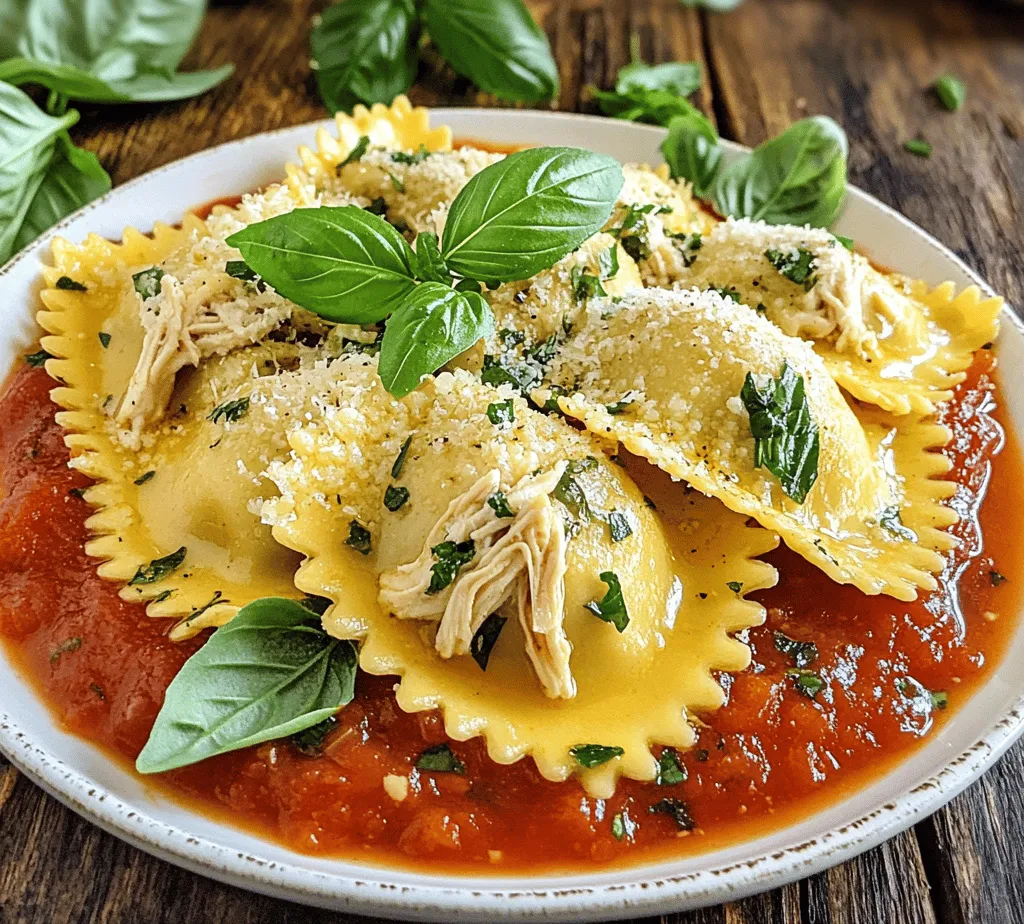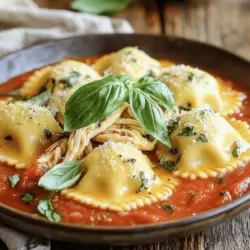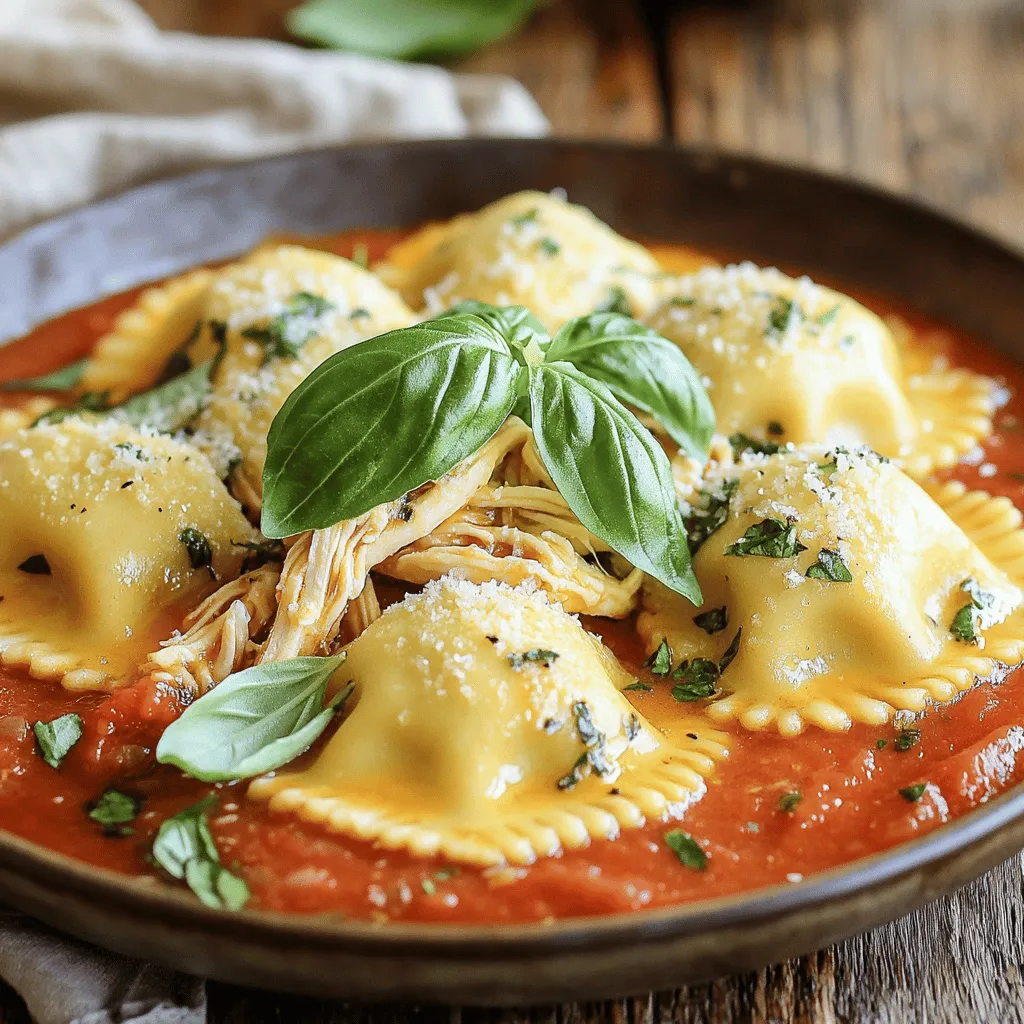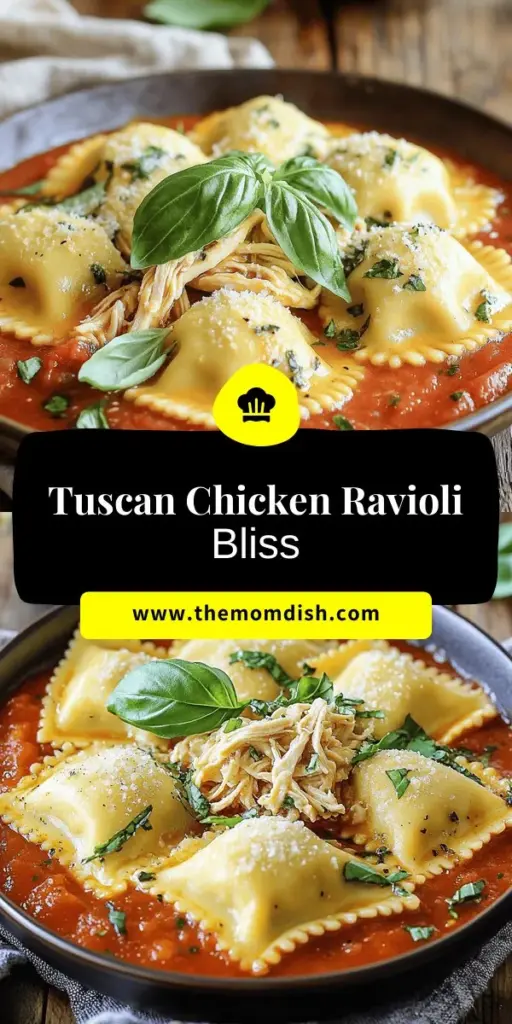Introduction to Tuscan Chicken Ravioli
Tuscan cuisine is a vibrant and hearty celebration of fresh ingredients, seasonal produce, and time-honored cooking techniques. Originating from the picturesque region of Tuscany in central Italy, this culinary tradition highlights the rustic flavors of the land, making it a treasure trove for pasta enthusiasts. Among the many delectable dishes that this region offers, ravioli stands out as a quintessential Italian comfort food. These delightful pasta pockets, often filled with savory ingredients, provide warmth and satisfaction that is hard to match.
Ravioli can be found in various fillings, but when it comes to Tuscan Chicken Ravioli, the combination of tender chicken, creamy ricotta, and fragrant herbs creates a mouthwatering experience that is both comforting and sophisticated. The beauty of this dish lies not only in its flavors but also in the process of crafting homemade pasta and filling. Making pasta from scratch can seem daunting, but the reward of enjoying your own creation is truly unparalleled.
In this article, we will delve into the world of Tuscan Chicken Ravioli, exploring its ingredients, techniques, and the satisfaction that comes with preparing this dish from scratch. With a few simple components, you can create a restaurant-quality meal that will impress family and friends alike.
Understanding the Ingredients
Before we dive into the step-by-step guide for making Tuscan Chicken Ravioli, let’s take a closer look at the essential ingredients that contribute to the rich flavors and textures of this dish.
All-Purpose Flour
All-purpose flour is the foundation of any pasta dough, providing the necessary structure and elasticity. When combined with eggs and kneaded properly, it creates a smooth and pliable dough that can be rolled out thinly. The quality of the flour plays a significant role in the final product, so opting for high-quality flour is essential for achieving the best results.
Eggs
Eggs are a vital ingredient in pasta making, contributing to both texture and flavor. The yolks add richness and create a beautiful golden hue in the dough. They also act as a binding agent, helping the dough come together while providing moisture. The protein in the eggs helps to create a stronger dough, which can withstand the filling and cooking process.
Olive Oil
Olive oil is often included in pasta recipes to enhance the flavor and improve the dough’s elasticity. A good-quality extra virgin olive oil adds a subtle fruity note to the pasta and helps to keep it from becoming too dry. When making ravioli, this ingredient also aids in achieving a tender and smooth texture.
Salt
Salt is an essential element that enhances the flavors of all the ingredients in the pasta and filling. It is important to season the dough adequately to ensure a well-balanced taste. Salt also strengthens the gluten structure in the dough, contributing to a more resilient pasta that holds up during cooking.
Cooked Chicken
Cooked chicken is the star of the filling in Tuscan Chicken Ravioli, providing a rich source of protein and flavor. Using leftover roasted chicken or boiled chicken breast is ideal, as it can be shredded or chopped into small pieces for easy incorporation into the filling. The chicken not only adds substance but also absorbs the flavors of the other ingredients, creating a cohesive taste profile.
Ricotta Cheese
Ricotta cheese is a key player in the filling, contributing creaminess and a delicate texture. It helps to bind the filling together while adding a mild, slightly sweet flavor. When mixed with other ingredients, ricotta lends a lightness to the filling, making it an ideal complement to the heartiness of the chicken.
Parmesan Cheese
Parmesan cheese is a must-have for any Italian dish, and it plays a crucial role in enhancing the savory depth of the ravioli filling. Grated Parmesan adds a salty, umami flavor that elevates the overall taste experience. It also helps to create a creamy texture in combination with ricotta, making every bite a delight.
Fresh Herbs (Basil and Parsley)
Fresh herbs, particularly basil and parsley, are integral to Tuscan cuisine, bringing vibrant flavors and nutritional benefits to the dish. Basil adds a sweet, aromatic note, while parsley provides a fresh, peppery taste. Together, they enhance the flavor of the filling and provide a burst of color that makes the dish visually appealing.
Garlic
Garlic is an aromatic ingredient that adds depth and warmth to the filling. It is widely used in Italian cooking for its robust flavor and numerous health benefits. Sautéing garlic before adding it to the filling helps to mellow its sharpness and infuse the dish with a savory aroma that will tantalize your senses.
Marinara Sauce
A classic pairing with ravioli, marinara sauce is a simple yet flavorful tomato-based sauce that complements the richness of the pasta and filling. Made with fresh tomatoes, garlic, and herbs, it provides a tangy contrast to the creamy filling. You can either make your marinara sauce from scratch or use a high-quality store-bought version for convenience.
Fresh Basil for Garnish
Finally, fresh basil is a perfect garnish for Tuscan Chicken Ravioli, adding an aesthetic appeal and an additional layer of flavor. A few fresh basil leaves scattered on top before serving not only elevates the dish visually but also enhances the overall dining experience with its fragrant aroma.
Step-by-Step Guide to Making Tuscan Chicken Ravioli
Now that we have a clear understanding of the ingredients, let’s get into the nitty-gritty of making Tuscan Chicken Ravioli. We’ll start with crafting the perfect pasta dough, which is essential for a successful ravioli experience.
Crafting the Perfect Pasta Dough
1. Creating the Flour Well
To begin, gather your all-purpose flour and place it on a clean work surface or in a large mixing bowl. Make sure to reserve some flour for dusting later. Create a well in the center of the flour mound, almost like a crater. This well will hold the eggs and other ingredients, ensuring they are properly incorporated into the flour without spilling over.
2. Incorporating Ingredients
Crack the eggs into the well, followed by a drizzle of olive oil and a pinch of salt. Using a fork, begin to whisk the eggs gently, gradually incorporating the flour from the inner rim of the well. Be careful to keep the flour contained within the well to avoid a mess.
3. Kneading the Dough
Once the mixture becomes too thick to mix with a fork, use your hands to bring the dough together. Knead the dough on a floured surface for about 10 minutes, or until it becomes smooth and elastic. This process is crucial; it develops the gluten, which gives the pasta its structure and chewiness.
4. Resting the Dough
After kneading, form the dough into a ball and wrap it in plastic wrap or cover it with a damp cloth. Allow it to rest for at least 30 minutes at room temperature. Resting the dough relaxes the gluten, making it easier to roll out later.
Preparing the Savory Chicken Filling
While the dough rests, it’s the perfect time to prepare the savory chicken filling that will elevate your ravioli.
1. Combining Ingredients for the Filling
In a large mixing bowl, combine the cooked chicken, ricotta cheese, grated Parmesan cheese, minced garlic, chopped fresh herbs (basil and parsley), and a pinch of salt and pepper. Mix the ingredients thoroughly until well combined, ensuring that the flavors meld together.
2. Achieving Texture and Flavor Balance
Taste the filling and adjust the seasoning if necessary. You want a well-balanced flavor that showcases the chicken and herbs. The filling should be creamy and cohesive, with each ingredient shining through. If the mixture seems too dry, add a little more ricotta or a splash of olive oil to achieve the desired consistency.
With the dough resting and the filling prepared, you are now ready to assemble your Tuscan Chicken Ravioli. The next steps will guide you through the process of rolling out the dough, filling it, and sealing the ravioli for cooking.
Stay tuned for the next part, where we will continue with the assembly and cooking process of this delightful dish!

Tips for Using Leftover Chicken Effectively
When it comes to creating Tuscan Chicken Ravioli, utilizing leftover chicken can be a game-changer in both flavor and efficiency. Here are some effective ways to repurpose leftover chicken into your ravioli filling:
1. Shred or Chop: Start by shredding or finely chopping your leftover chicken. This ensures that the chicken easily incorporates with other filling ingredients, creating a harmonious blend of flavors.
2. Flavor Boost: If your leftover chicken is plain, enhance its flavor by sautéing it with garlic, onions, or your favorite Tuscan herbs (like rosemary or thyme) before mixing it into your filling. This will elevate the taste and add a depth that complements the ravioli perfectly.
3. Combine with Cheeses: Mix the chicken with ricotta or mascarpone cheese for a creamy texture. This not only adds richness but also helps bind the filling together, making it easier to scoop into your ravioli.
4. Add Vegetables: Incorporating diced spinach, sun-dried tomatoes, or sautéed mushrooms can add color, nutrition, and a delightful textural contrast to your filling.
Rolling and Shaping the Ravioli
Creating ravioli from scratch can be a rewarding experience. Here’s how to roll and shape your dough effectively:
Techniques for Rolling Out Dough: Tools and Methods
1. Use a Pasta Machine: The most efficient way to roll out pasta dough is with a pasta machine. Start with a small portion of dough, flatten it slightly with your hands, and run it through the machine on the widest setting. Gradually narrow the setting until you achieve a thin, even sheet.
2. Rolling Pin Method: If you don’t have a pasta machine, a rolling pin will suffice. Flour your work surface and the dough lightly to prevent sticking. Roll the dough from the center outward, rotating it occasionally to maintain an even thickness.
How to Cut and Fill the Ravioli: Ensuring a Perfect Seal
1. Cutting the Dough: Once you have rolled out the dough, use a sharp knife or pastry cutter to create uniform squares or circles, depending on your preferred ravioli shape. Aim for about 2-3 inches in diameter.
2. Filling the Ravioli: Place a small spoonful of filling (around one teaspoon) in the center of each cut piece. Be careful not to overfill, as this can make sealing difficult.
3. Sealing the Edges: Moisten the edges of the dough with a bit of water. Fold the dough over the filling, pressing firmly to remove air pockets and seal the edges. Ensure that the filling is completely enclosed to prevent it from leaking during cooking.
Decorative Crimping with a Fork: Enhancing Presentation
For an added touch of elegance, you can crimp the edges of your ravioli with a fork. Gently press the tines of the fork along the sealed edges to create a decorative pattern, ensuring a tight seal that enhances both the look and texture of your ravioli.
Cooking the Ravioli to Perfection
Importance of Boiling Water and Salting: Enhancing Flavor
To cook your ravioli perfectly, bring a large pot of salted water to a rolling boil. The salt not only flavors the pasta but also helps maintain the structure during cooking. Use about one tablespoon of salt for every four quarts of water—this will ensure your ravioli are flavorful from the inside out.
Recognizing When Ravioli Are Done: Key Signs to Look For
Fresh ravioli typically cook quickly, within 3-4 minutes. They are done when they float to the surface of the water and appear slightly plump. To test, you can take one out and cut it open; the filling should be hot and the pasta tender but not mushy.
Serving the Dish
Heating Marinara Sauce: Proper Technique for Flavor Infusion
While your ravioli are cooking, heat your marinara sauce in a separate saucepan over medium heat. Stir occasionally to prevent sticking, allowing the flavors to meld. For an extra flavor boost, consider adding a pinch of red pepper flakes or a splash of white wine to the sauce for a touch of acidity.
Plating Tips for an Appealing Presentation
Once your ravioli are cooked, drain them gently and add them to the pot with the heated marinara. Toss lightly to coat without breaking the delicate pasta. For plating, use a large spoon to create a nest of ravioli in the center of the plate, then drizzle additional sauce around the edges for a beautiful presentation.
Garnishing with Fresh Basil and Parmesan: Final Touches for Enhancement
Finish your dish with a sprinkle of freshly grated Parmesan cheese and a few leaves of basil for color and flavor. This not only enhances the dish visually but also adds fragrant herbal notes that complement the richness of the sauce and filling.
Nutritional Benefits of Tuscan Chicken Ravioli
Overview of the Nutritional Value of the Ingredients
Homemade Tuscan Chicken Ravioli offers a balanced combination of nutrients, thanks to its wholesome ingredients. The ravioli dough, filled with protein-rich chicken and cheese, serves as a satisfying meal that can be both nutritious and indulgent.
Protein Content from Chicken and Cheese
Chicken is an excellent source of lean protein, essential for muscle growth and repair. When combined with cheese, which is also a good source of protein and calcium, this dish contributes significantly to your daily protein intake, making it a hearty meal option.
Vitamins and Minerals from Fresh Herbs
Fresh herbs such as basil and parsley not only elevate the flavor of your dish but also provide essential vitamins and minerals. Basil is rich in vitamins A, C, and K, while parsley adds a boost of antioxidants, promoting overall health.
Balanced Meal Potential with Pasta and Sauce
With the carbohydrates from the pasta, proteins from the filling, and vitamins from the sauce, Tuscan Chicken Ravioli can be considered a well-rounded dish. Pair it with a side salad or some steamed vegetables to complete your meal and ensure a variety of nutrients.
Cultural Significance of Ravioli in Italian Cuisine
Historical Background of Ravioli in Italy
Ravioli has a rich history in Italian cuisine, dating back to the 14th century. Originally a way to use leftover ingredients, ravioli was created as a practical solution to minimize waste. Over the centuries, it has evolved into a beloved dish, often served during family gatherings and celebrations.
Regional Variations and Their Unique Flavors
Italy boasts a plethora of ravioli variations, each reflecting its region’s local ingredients and culinary traditions. From the cheese-filled ravioli of Liguria to meat-stuffed versions found in Emilia-Romagna, each type offers a unique taste of Italian heritage. These regional specialties showcase the versatility and adaptability of ravioli in Italian cooking.
The Role of Homemade Pasta in Family Traditions
Making ravioli from scratch is a cherished tradition in many Italian families. It often involves generations coming together, sharing stories, and passing down recipes. This communal activity brings families closer and keeps culinary traditions alive, reinforcing the cultural significance of homemade pasta in Italian cuisine.
Conclusion: The Joy of Homemade Tuscan Chicken Ravioli
Creating Tuscan Chicken Ravioli from scratch is not just about the food; it’s about the experience. The process of mixing the dough, preparing the filling, and shaping each ravioli can be a joyful, meditative activity that connects you to your culinary roots. The flavors and textures that come together in this dish are a celebration of Italian cooking—rich, comforting, and utterly satisfying.
As you enjoy this delightful meal, consider sharing the experience with family and friends. Homemade ravioli can turn an ordinary dinner into a memorable occasion, filled with laughter and shared stories. Embrace the joy of cooking and the warmth it brings into your home, and let this Tuscan Chicken Ravioli recipe become a cherished part of your culinary repertoire.



